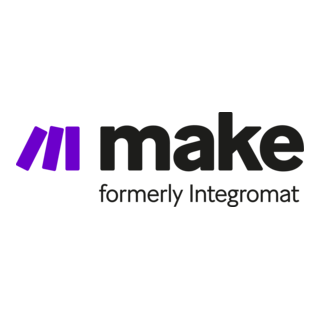Make: Visual Automation for Complex Workflows
Make (formerly Integromat) stands as one of the most powerful no-code automation platforms, enabling users to create sophisticated workflows through an intuitive visual interface. With advanced logic capabilities, extensive integration options, and robust error handling, Make serves businesses and developers who need more control and flexibility than traditional automation tools provide, supporting over 1,400 applications and services.
Make's 2025 Power:
- Visual scenario builder for complex workflow design
- 1,400+ app integrations with advanced customization
- Advanced logic & control with loops, filters, and conditionals
- Real-time execution with detailed monitoring
- Enterprise-grade features for scalable automation
Platform Overview
Founded in 2012 as Integromat and rebranded to Make in 2021, the platform was created to provide more sophisticated automation capabilities than simpler tools could offer. With a focus on visual workflow design and advanced logic, Make has become the go-to choice for businesses and developers who need powerful automation without traditional coding.
Make Platform Overview | Metric | Details |
| Founded | 2012 (as Integromat) |
| Rebranded | 2021 (to Make) |
| Headquarters | Prague, Czech Republic |
| Users | 500,000+ users worldwide |
| Organizations | 83,000+ companies |
| App Integrations | 1,400+ applications supported |
| Operations Executed | Billions of operations monthly |
| Enterprise Customers | Fortune 500 companies |
Automation Engine & Building
Advanced Visual Scenario Builder
- Drag-and-Drop Interface Intuitive visual workflow creation with connected modules
- Module-Based Architecture Modular approach for building complex automation scenarios
- Real-Time Preview See data flow and results as you build workflows
- Blueprint Templates Pre-built scenarios for common automation needs
Visual Power: Make's scenario builder allows users to create complex workflows with multiple paths, conditions, and data transformations while maintaining visual clarity of the entire process flow.
Advanced Logic & Control Flow
- Conditional routing: Route data based on complex conditions and rules
- Loops and iterations: Process arrays and repeat actions automatically
- Data aggregation: Combine and process multiple data sources
- Variable storage: Store and reuse data throughout scenarios
- Mathematical operations: Perform calculations and data transformations
Robust Error Handling & Monitoring
Make Error Handling Features | Feature | Capability | Business Value |
| Error Directives | Define how to handle specific errors | Automated error resolution |
| Break Points | Pause execution for manual intervention | Controlled automation flow |
| Retry Logic | Automatically retry failed operations | Improved reliability |
| Rollback Mechanisms | Undo operations when errors occur | Data integrity protection |
Integrations & Connectivity
Extensive Application Ecosystem
- 1,400+ Native Apps Comprehensive library of pre-built app connections
- Popular Business Tools CRM, email marketing, project management, e-commerce
- Developer-Friendly APIs Advanced API configurations and custom headers
- Database Connections Direct integration with SQL databases and data warehouses
Advanced API & Webhook Support
- HTTP modules: Make custom API calls to any REST endpoint
- Webhook triggers: Instant automation triggered by external events
- JSON/XML parsing: Advanced data parsing and transformation
- Authentication support: OAuth, API keys, basic auth, custom auth
- Request customization: Headers, parameters, body formatting
Custom Integration Development
Custom Integration Options | Integration Type | Complexity | Use Cases |
| HTTP Modules | Beginner to Intermediate | API calls, webhooks, data fetching |
| Private Apps | Intermediate | Internal systems, custom APIs |
| Public Apps | Advanced | Marketplace apps, shared integrations |
| SDK Development | Expert | Complex enterprise integrations |
Advanced Automation Features
Powerful Data Processing
- Data Transformation Convert, format, and manipulate data between apps
- Text Processing String manipulation, regex, text formatting functions
- Date & Time Operations Date calculations, timezone conversions, scheduling
- File Processing Upload, download, convert, and manipulate files
Advanced Conditional Logic
- Filter conditions: Complex filtering with multiple criteria
- Router modules: Split scenarios into multiple execution paths
- Switch statements: Multi-way conditional branching
- Boolean logic: AND, OR, NOT operations for complex conditions
- Data comparison: Compare values, dates, numbers, and text
Flexible Scheduling & Triggers
Make Trigger Types | Trigger Type | Frequency Options | Best For |
| Scheduled Triggers | Minutes to months, cron expressions | Regular maintenance, reports |
| Instant Triggers | Real-time webhooks | Immediate response to events |
| Polling Triggers | Customizable intervals | Checking for new data |
| Manual Triggers | On-demand execution | Testing, one-time operations |
Team Collaboration & Management
Team Development Features
- Team Workspaces Shared environments for collaborative scenario development
- Version Control Track changes and maintain scenario version history
- Role-Based Access Granular permissions for team members and scenarios
- Scenario Sharing Share and clone scenarios between team members
Organization Management
- User management: Add, remove, and manage team member access
- Organization settings: Centralized configuration and policies
- Usage monitoring: Track team usage and operations consumption
- Billing management: Consolidated billing and usage reports
- Admin controls: Organization-wide settings and restrictions
Advanced Permissions & Security
Make Permission Levels | Permission Level | Access Rights | Typical Use Cases |
| Owner | Full access, billing, user management | Organization administrators |
| Admin | User management, scenario oversight | Team leads, IT managers |
| Member | Create and edit scenarios | Developers, automation specialists |
| Viewer | View scenarios and execution logs | Stakeholders, auditors |
Monitoring & Analytics
Comprehensive Execution Monitoring
- Real-Time Execution Watch scenarios execute with live data flow visualization
- Execution History Detailed logs of all scenario runs and outcomes
- Error Tracking Comprehensive error logs with troubleshooting information
- Performance Metrics Execution times, success rates, and efficiency data
Usage Analytics & Reporting
- Operations tracking: Monitor operations consumption and limits
- Scenario performance: Analyze which scenarios are most active
- Error analytics: Identify patterns in failed executions
- Team usage: Track usage across team members and scenarios
- Cost optimization: Understand operational costs and optimize usage
Pricing Structure & Plans
Make Pricing Plans | Plan | Price | Operations | Best For |
| Free | $0 | 1,000 operations/month | Personal use, testing |
| Core | $9/month | 10,000 operations/month | Small businesses, freelancers |
| Pro | $16/month | 40,000 operations/month | Growing businesses |
| Teams | $29/month | 80,000 operations/month | Team collaboration |
| Enterprise | Contact sales | Custom operations limit | Large organizations |
Make's pricing is based on operations (individual actions), making it cost-effective for complex scenarios while providing clear usage tracking and predictable costs.
Learning Resources & Support
Make Learning & Support | Resource Type | Content | Audience |
| Make Academy | Comprehensive video tutorials | All skill levels |
| Documentation | Detailed guides and references | Developers and advanced users |
| Community Forum | User discussions and solutions | All users |
| Template Gallery | Pre-built scenarios for learning | Beginners and quick starts |
| Professional Services | Custom development and training | Enterprise customers |
Learning Timeline: Basic Make scenarios can be created in 1-2 hours, while mastering advanced features like complex logic and error handling typically requires 2-4 weeks of regular practice.
Advantages and Disadvantages
✅ Pros
- Extremely powerful visual automation capabilities
- Advanced logic features for complex workflows
- Extensive integration library with 1,400+ apps
- Excellent error handling and debugging tools
- Real-time execution monitoring and analytics
- Flexible API support for custom integrations
- Cost-effective pricing based on operations
- Strong community and learning resources
❌ Cons
- Steeper learning curve than simpler automation tools
- Complex interface can be overwhelming for beginners
- Operations counting can be confusing for new users
- Advanced features require technical understanding
- Limited mobile app for scenario management
- Performance can vary with very complex scenarios
- Documentation depth varies between integrations
Final Verdict
Make excels as a sophisticated automation platform that bridges the gap between simple automation tools and custom development. Its strength lies in providing enterprise-grade automation capabilities through a visual interface, making complex workflows accessible to technical users without requiring traditional programming skills.
While the learning curve is steeper than simpler alternatives, the investment pays off with unprecedented control over automation logic, error handling, and integration capabilities. Make is ideal for businesses that have outgrown basic automation tools but aren't ready for custom development solutions.
Bottom Line: Choose Make for advanced automation needs requiring complex logic, extensive integrations, and enterprise-grade reliability. Perfect for technical teams and businesses with sophisticated workflow requirements.
Make Is Best For:
- Businesses needing complex automation with advanced logic
- Technical teams comfortable with detailed workflow design
- Organizations requiring extensive API integrations
- Companies needing robust error handling and monitoring
- Teams that have outgrown simpler automation tools
Consider Alternatives If:
- You need simple, straightforward automation workflows
- Your team prefers minimal learning curves
- You're looking for basic app-to-app connections
- Budget is a primary concern for small-scale automation
- You need extensive pre-built templates and recipes



